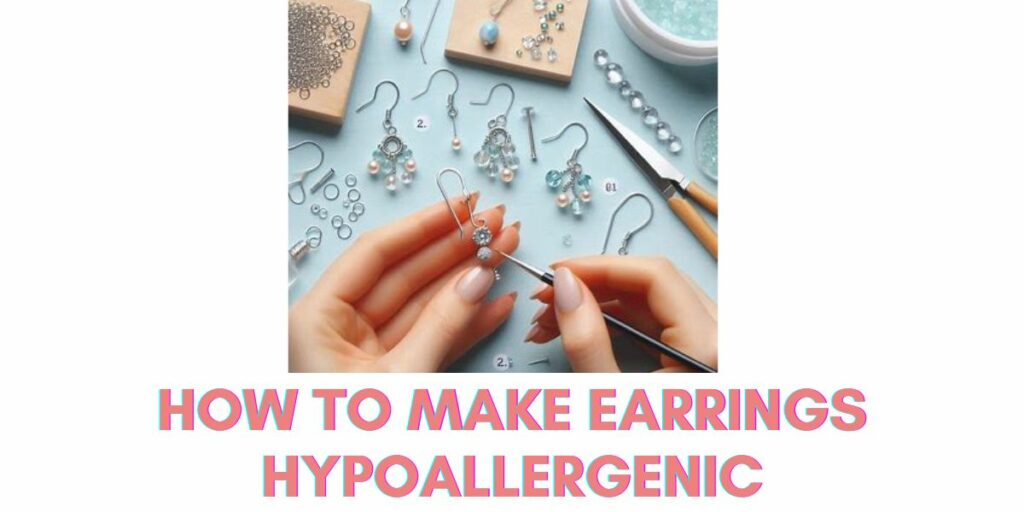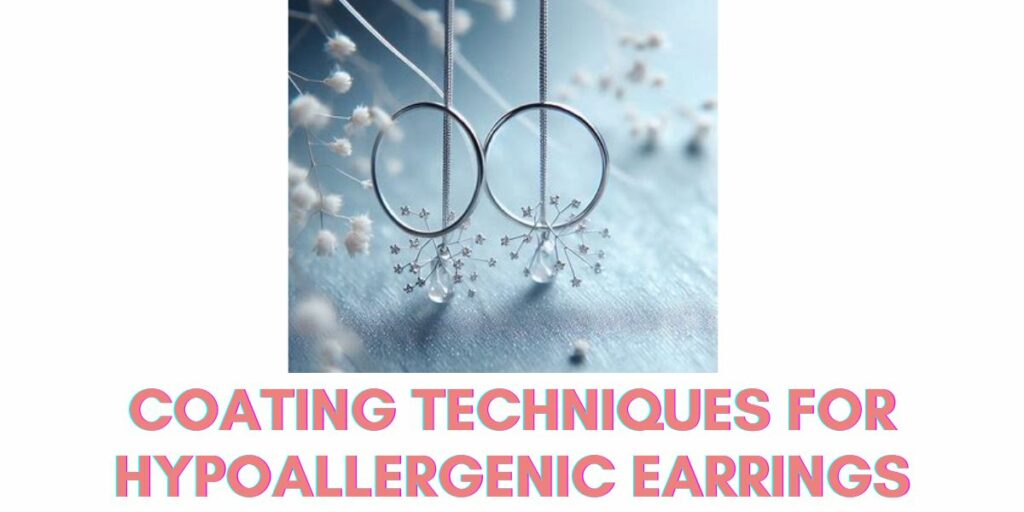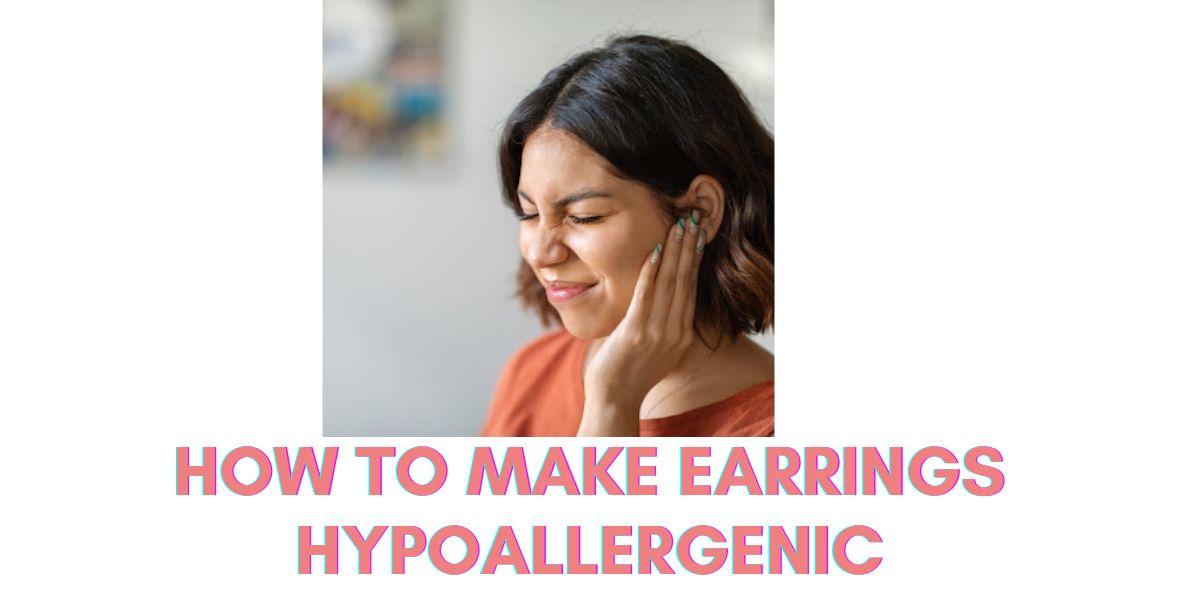Have you ever fallen in love with stunning earrings, only to discover they make your ears itch and turn red?
Trust me, I’ve been there. My excitement turned into disappointment quicker than you can say, “allergic reaction.”
Recently, I discovered the secret to enjoying all the fabulous earrings without the irritation.
In this article, I’ll explain how to make earrings hypoallergenic so you can rock your favorite styles without the itch.
How to Make Earrings Hypoallergenic

Follow these steps to make earrings hypoallergenic:
1. Surface Preparation
Clean the earrings thoroughly to remove dirt, oils, or residues. A clean surface ensures proper adhesion of the specialized coating.
2. Select Hypoallergenic Coating
Choose an appropriate hypoallergenic coating based on the material of the earrings.
3. Clean the Earrings
Clean the earrings thoroughly before applying any coatings or treatments to remove any dirt, oils, or residue. Use a gentle soap and water solution or a jewelry cleaning solution to clean the metal components.
4. Masking and Protection
Carefully mask or cover areas that should not receive the coating, such as gemstones or specific design elements. This step ensures that only the intended surfaces undergo the coating process.
5. Application Method
- For clear nail polish coating: Use a small brush to apply a thin, even layer of clear nail polish to the metal components such as earring posts or hooks. Allow the nail polish to dry completely before wearing the earrings.
- For resin coating: Mix epoxy resin and hardener according to the manufacturer’s instructions, then use a small brush or applicator to apply the resin mixture to the metal parts of the earrings. Allow the resin to cure and harden completely before wearing the earrings.
- For polymer clay coating: Shape and mold hypoallergenic polymer clay around the metal components of the earrings, ensuring complete coverage. Bake the earrings in an oven according to the manufacturer’s instructions to cure the polymer clay.
- For silicone coating: Apply a thin layer of liquid silicone to the metal parts of the earrings using a small brush or applicator. Allow the silicone to cure and dry completely before wearing the earrings.
6. Even Application
Ensure an even and consistent coating application across all earrings’ surfaces. This helps achieve a uniform protective layer and enhances the effectiveness of the hypoallergenic barrier.
7. Curing or Drying
Allow the coated earrings to undergo the process as the coating manufacturer specifies. This step is crucial for the coating to bond securely with the earring surface and form a resilient, hypoallergenic layer.
8. Inspection
Conduct a thorough quality check to ensure the coating has been applied accurately and uniformly.
9. Post-Application Treatment
Depending on the coating type, there may be additional post-application treatments, such as polishing or buffing, to enhance the finish and overall aesthetic of the earrings.
If you’re struggling with allergies and seeking the perfect solution to continue wearing jewelry comfortably, you might find our article on the Best Jewelry Coating for Allergies incredibly helpful.
Materials Needed to Make Earrings Hypoallergenic
These are the materials needed to make earrings hypoallergenic:
- Hypoallergenic Metals: Choose metals less likely to cause allergic reactions, such as surgical stainless steel, titanium, niobium, pure gold, or platinum. These metals are commonly available in earring findings like earring posts, hooks, and hoops.
- Clear Nail Polish: Clear nail polish can coat the metal parts of earrings, creating a protective barrier between the skin and the metal. Use a high-quality, hypoallergenic nail polish without any added harsh chemicals.
- Earring Backs: Opt for plastic or silicone earring backs instead of metal ones, as they are less likely to irritate. These earring backs provide a secure fit while minimizing direct contact between the metal and the skin.
- Resin or Epoxy: If you prefer a more durable coating, you’ll need epoxy or jewelry-grade resin. This material can be mixed and applied to the metal components of the earrings, providing a long-lasting protective layer.
- Polymer Clay: Polymer clay can be shaped and molded around earring posts or hoops to create a comfortable barrier between the metal and the skin. Choose hypoallergenic polymer clay in your preferred colors and textures.
- Liquid Silicone: Liquid silicone can create a flexible and skin-friendly coating for earrings. Look for medical-grade silicone safe for prolonged skin contact and provides excellent hypoallergenic properties.
- Small Brushes or Applicators: You’ll need small brushes or applicators to apply clear nail polish, resin, or silicone to the metal components of the earrings. Choose brushes with fine bristles for precise application.
- Protective Gear: When working with resin or epoxy, wear protective gear such as gloves and goggles to prevent skin contact and eye irritation.
Top 3 Hypoallergic Earrings
These are the top 3 hypoallergenic earrings:
1. Hypoallergenic Titanium Stud Earrings for Newly Pierced Ears
These titanium stud earrings are perfect for newly pierced ears, offering style and comfort. Made from hypoallergenic titanium, they are gentle on sensitive skin and reduce the risk of irritation or allergic reactions.
2. Surgical Post Earring Set for Newly Pierced Ears
This earring set is specifically designed for sensitive ears, featuring surgical-grade posts that are gentle on sensitive skin. The set includes a variety of stud earrings in different styles and sizes, allowing for versatility.
3. White Pearl Hypoallergenic Earrings for Newly Pierced Ears
The lustrous pearls are set on surgical-grade posts, ensuring comfort and safety for sensitive ears. These earrings offer timeless beauty without the risk of irritation or allergic reactions.
Coating Techniques for Hypoallergenic Earrings

These are the coating techniques for hypoallergenic earrings:
1. Clear Nail Polish Coating:
- Clean the metal parts of the earrings thoroughly to remove any dirt or oils.
- Apply a thin, even layer of clear nail polish to the metal components such as earring posts, hooks, or hoops.
- Allow the nail polish to dry completely before wearing the earrings.
- Reapply the clear nail polish periodically to maintain the protective coating.
2. Polymer Clay:
- Shape and mold hypoallergenic polymer clay around the metal components of the earrings, such as earring posts or hoops.
- Ensure that the clay completely covers the metal and forms a smooth surface.
- Bake the earrings in an oven according to the manufacturer’s instructions to cure the polymer clay.
- Once cooled, the polymer clay forms a flexible and comfortable barrier between the metal and the skin.
2. Vaseline or Neosporin Protective Layer: If you’re hesitant about using nail polish or don’t have any, smear Vaseline or Neosporin on the earring posts before wearing them.
3. Coconut Oil Barrier: Dip your earrings briefly in coconut oil before wearing them to establish a barrier between the metal and your skin.
4. Consider Hypoallergenic Earring Backs: Opt for earring backs made of hypoallergenic materials like gold, silver, or stainless steel. Avoid materials like plastic that may cause skin irritation.
5. Jewelry Coating for Allergies: Consider using a jewelry coating designed for allergies. These coatings create a hypoallergenic barrier, minimizing direct skin contact with potential allergens.
6. Silicon Coating
- Using a small brush or applicator, apply a thin layer of liquid silicone to the metal parts of the earrings.
- Ensure the silicone covers the metal completely, forming a smooth, even coating.
- Allow the silicone to cure and dry completely before wearing the earrings.
- Silicone coatings are soft, flexible, and comfortable, making them an excellent choice for individuals with sensitive ears.
7. Change Earring Wires: Switch earring wires or post to hypoallergenic metals.
8. UV Resin Coating:
- Mix epoxy resin and hardener according to the manufacturer’s instructions.
- Use a small brush or applicator to apply the resin mixture to the metal parts of the earrings, ensuring complete coverage.
- Allow the resin to cure and harden according to the manufacturer’s recommendations.
- Once cured, the resin forms a durable, transparent coating that protects the metal from direct contact with the skin.
Check out our article on Types of Earrings with Names and Pictures to explore various earrings with their names and pictures.
FAQs on How to Make Earrings Hypoallergenic
These are frequently asked questions about how to make earrings hypoallergenic:
What Materials Are Used to Make Hypoallergenic Earrings?
Hypoallergenic earrings are typically made from materials that are less likely to cause allergic reactions in sensitive individuals. Common materials include surgical stainless steel, titanium, niobium, pure gold, platinum, and certain plastics or silicone.
How Can One Convert Existing Earrings to Be Safe for Sensitive Ears?
Existing earrings can be converted to be safe for sensitive ears using various methods. These may include coating the metal parts with clear nail polish, resin, silicone, or polymer clay to create a protective barrier. Replacing earring backs with hypoallergenic options and changing earring wires to non-reactive metals can help minimize allergic reactions.
What Hypoallergenic Metals Are Good for People With Nickel Allergies?
People with nickel allergies should opt for hypoallergenic metals that will not trigger allergic reactions. Suitable options include surgical stainless steel, titanium, and niobium.
Why Do Earrings Cause Reactions Like Itching and Scabbing?
Earrings can cause reactions like itching and scabbing due to contact dermatitis, an allergic reaction to certain metals found in jewelry.
Conclusion
In conclusion, it’s clear that how to make earrings hypoallergenic isn’t rocket science but can make a difference in your comfort and style. Whether you opt for hypoallergenic materials like titanium or take steps to coat your favorite pairs, there’s a solution for everyone. Say goodbye to irritated ears and hello to endless earring options. So go ahead, experiment, and enjoy accessorizing without worry. Your ears will thank you.

